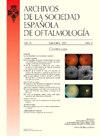Queratitis herpética después de crosslinkig corneal
Q3 Medicine
Archivos De La Sociedad Espanola De Oftalmologia
Pub Date : 2025-07-01
DOI:10.1016/j.oftal.2024.11.012
引用次数: 0
Abstract
Corneal crosslinking is considered a safe procedure even if sight-threatening side effects have been reported. Other han our case report, few reports of herpetic keratitis (HK) after crosslinking have been published. We report a new onset HK after corneal crosslinking for keratoconus.
A 40-year-old woman underwent corneal collagen crosslinking in her right eye for progressive keratoconus. The patient returned with pain and photophobia. Infiltration in the corneal stroma was observed. Fluorescein staining specified epithelial defects overlying the corneal infiltrates.
The diagnostic of HK was confirmed with polymerase chain reaction for DNA detection of HSV type 1 of corneal swab. The epithelial defect healed with oral valacyclovir treatment.
Topical corticosteroid drops and preservative-free lubricant eye drops were, also, added to the antiviral treatment. Afterwards, a decrease in stromal infiltrate was observed.
This case report highlights the risk of HK after crosslinking and elucidates the importance of timely diagnosis of this unusual but important complication. The ophthalmologist should be aware of the possibility of HK in eyes after crosslinking, even in patients without a past medical history of HSV infection.
角膜交叉连接后疱疹性角膜炎
角膜交联被认为是一种安全的手术,即使有威胁视力的副作用报道。除了我们的病例报告外,交联后疱疹性角膜炎(HK)的报道很少。我们报告圆锥角膜交联后新发的HK。一位40岁的女性在她的右眼接受角膜胶原交联治疗进行性圆锥角膜。病人回来时感到疼痛和畏光。角膜基质中可见浸润。荧光素染色显示角膜浸润上的上皮缺陷。采用角膜拭子HSV 1型DNA检测聚合酶链反应证实HK的诊断。上皮缺损在口服伐昔洛韦治疗后愈合。局部皮质类固醇滴剂和不含防腐剂的润滑剂滴眼液也被添加到抗病毒治疗中。之后,观察到间质浸润减少。本病例报告强调了交联后HK的风险,并阐明了及时诊断这种不寻常但重要的并发症的重要性。眼科医生应该意识到交联后眼睛出现HK的可能性,即使是没有HSV感染病史的患者。
本文章由计算机程序翻译,如有差异,请以英文原文为准。
求助全文
约1分钟内获得全文
求助全文
来源期刊

Archivos De La Sociedad Espanola De Oftalmologia
Medicine-Ophthalmology
CiteScore
1.20
自引率
0.00%
发文量
109
审稿时长
78 days
期刊介绍:
La revista Archivos de la Sociedad Española de Oftalmología, editada mensualmente por la propia Sociedad, tiene como objetivo publicar trabajos de investigación básica y clínica como artículos originales; casos clínicos, innovaciones técnicas y correlaciones clinicopatológicas en forma de comunicaciones cortas; editoriales; revisiones; cartas al editor; comentarios de libros; información de eventos; noticias personales y anuncios comerciales, así como trabajos de temas históricos y motivos inconográficos relacionados con la Oftalmología. El título abreviado es Arch Soc Esp Oftalmol, y debe ser utilizado en bibliografías, notas a pie de página y referencias bibliográficas.
 求助内容:
求助内容: 应助结果提醒方式:
应助结果提醒方式:


